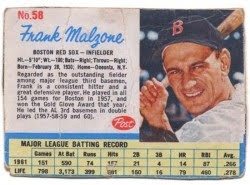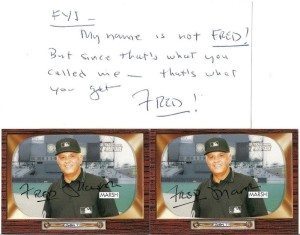
Wes Westrum’s baseball heyday came in New York. He logged a decade catching for the Giants, racking up two All-Star team nods and a 1954 World Championship ring. Westrum returned to the Big Apple as a Mets coach, becoming manager when Casey Stengel fractured his hip and was forced to retire.
All those New York headlines could never match the drama of Westrum’s Minnesota roots. I grew in admiration for any Minnesota native developing as a major leaguer after reading Stew Thornley’s fine Baseball in Minnesota: A Definitive History Thornley has documented the rise of Westrum and his Minnesotan counterparts in Minnesotans in Baseball
Before he died at age 79 in 2002, Westrum sent an epic description of his evolution as a baseball player. (I asked about his place in Minnesota baseball history, along with memories of other native sons. Mentioning that my wife was born in Redwood Falls may have helped increase my chances at a response!)
Westrum wrote:
“Spent all my youth in all the sports. My father died at an early age (37). Baseball was the quickest way to help the family. I was a better football player and had a scholarship to Minnesota. Played pro baseball while in high school so I couldn’t go. Played basketball at Bemidji State Teachers one year before Uncle Sam got me.
Caught Paul Giel in his first game with the New York Giants. Great competitor and wonderful fellow. I was Jerry Koosman’s coach and manager with the New York Mets. Great person.
Russ Rolandson from Alexandria was with us in 1947 with Minneapolis Millers. He was a catcher from the College of Hamline.
Bill Dickey of the Yankees was my idol growing up in the small town of Clearbrook, Minnesota. The people of Clearbrook took up a small collection of $65 to send me to the Crookston (MN) Pirates in my junior year of high school. I made the (minor league) team.
Lots of fond memories of those days. Best always, ‘Wes’ Westrum”
The local hero did return. Westrum passed away in Clearbrook, Minnesota May 28, 2002. Did his friends and neighbors realize they were investing $65 in an all-star career? Clearbrook did in 1990, opening the Wes Westrum Baseball Museum.
One grateful catcher never forgot one hometown’s kindness.


